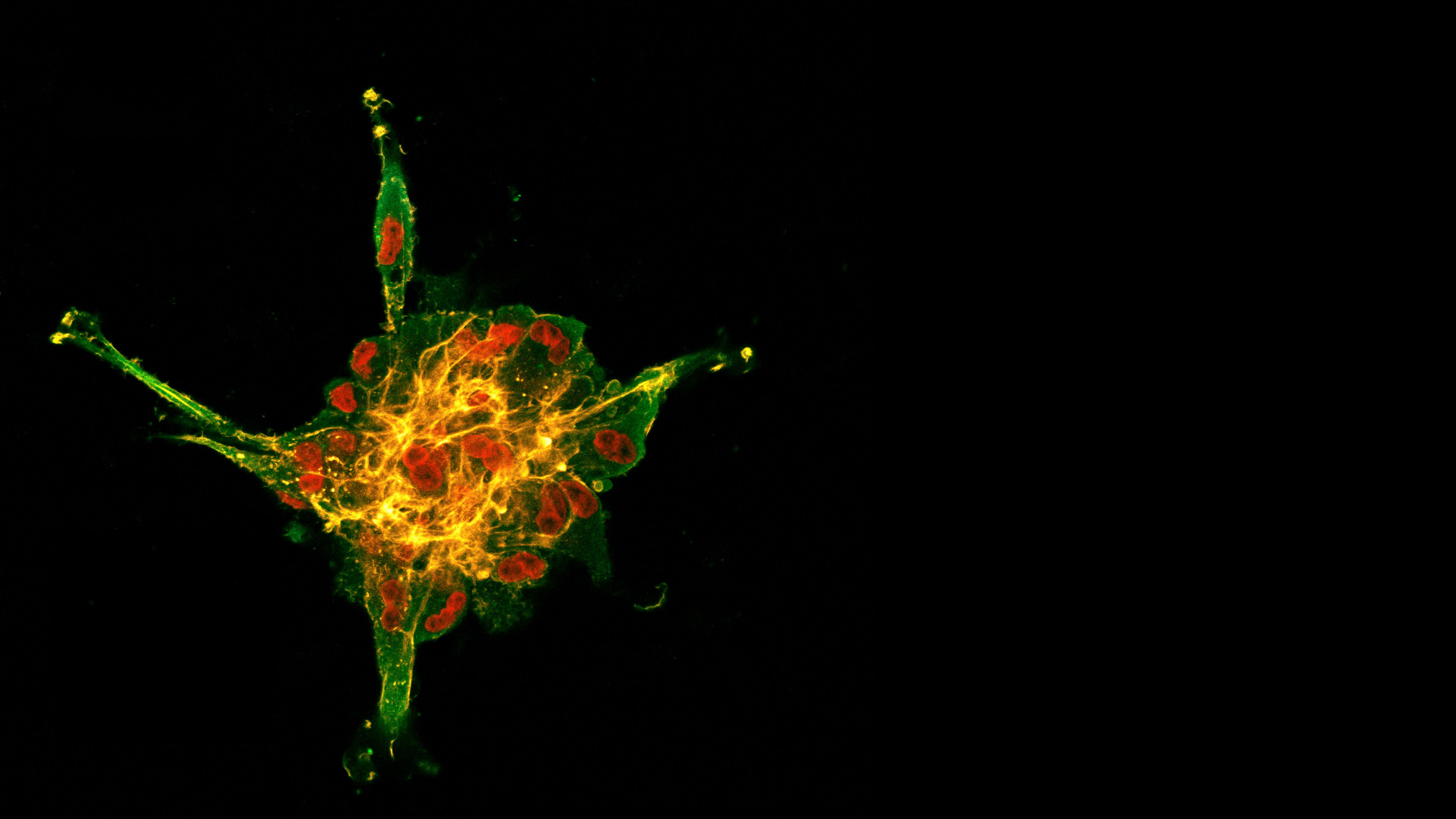Stunning stem cells and Starlink trails —November’s best science images
The month’s sharpest science shots, selected by Nature’s photo team.

Stem-cell spheroid. This is a cluster made out of the stem cells found in dental pulp — the innermost layer of the tooth. These cells are derived from the neural crest, the part of an embryo that goes on to form the nervous system as well as bones in the face and skull. Because they share characteristics with neural stem cells, dental pulp stem cells could one day find applications in regenerative medicine — including treatments for spinal cord injury or Alzheimer’s disease — says Shuntaro Yamada, a stem-cell biologist and dentist at the University of Bergen, Norway.
Sacred space. Archaeologists have excavated five 1,000-year-old mummies — the remains of four children and one adult — in Lima, alongside ceramics and other artefacts. The mummies come from the pre-Inca Ychsma culture that developed on the central coast of Peru around AD 900 and lived there until the mid-1400s. They were found at the foot of a staircase on a small hill that was probably part of a temple built by an earlier culture, 3,500 years ago.
“This whole area is a very important ceremonial chamber,” archaeologist Luis Takuda told Reuters. “The people who lived here during the Ychsma period still considered it a sacred space and therefore buried their dead here.”
Credit: Anthony Marina/Reuters
This video has no sound. Credit: NASA/JPL-Caltech
This video has no sound. Credit: NASA/JPL-Caltech
Blue planet. The Surface Water and Ocean Topography (SWOT) satellite is measuring the surface heights of nearly all bodies of water on Earth, providing one of the most detailed views yet of the planet’s oceans, lakes and rivers. This animation shows data on sea levels worldwide collected between 26 July and 16 August. Yellow, red and orange indicate ocean surface heights higher than the global average, and blue represents heights lower than average. SWOT was jointly developed by NASA and the French space agency CNES.

Credit: Kyodo News via AP/Alamy
Credit: Kyodo News via AP/Alamy
Land ahoy. A tiny island measuring just 100 metres across has emerged in the Pacific Ocean near Iwoto Island, about 1,200 kilometres south of Tokyo, after a series of underwater volcanic eruptions began on 21 October. Plumes of gas and steam were spotted rising from the water every few minutes during the volcanic activity, as magma came into contact with seawater. Researchers say the new island could carry on growing if the eruptions continue.

Credit: Jacquie Matechuk/NPOTY 2023
Credit: Jacquie Matechuk/NPOTY 2023
Natural beauty. This snap of a male spectacled bear (Tremarctos ornatus) relaxing in a fig treecovered in Spanish moss won the Nature Photographer of the Year competition. Wildlife-conservation photographer Jacquie Matechuk endured difficult terrain and weather conditions for 11 days in the Ecuadorean Andes to observe these bears, which are native to South America. “We kept a respectful distance to ensure their comfort and it paid off in spades,” said Matechuk in her competition entry. “They would nurse, fall asleep, cuddle, forage, and play, seemingly more oblivious to our presence with each passing encounter.”
Satellite trails. This long-exposure photo shows a trail produced by SpaceX’s Starlink satellites passing over Uruguay. The planet Venus can be seen on the left. Thousands of these small satellites — which help to provide broadband Internet and mobile-phone service — have been launched over the past few years, but astronomers are concerned that the trails’ appearance across the night sky is causing problems for ground-based imaging.
Credit: Mariana Suarez/AFP via Getty

Tasty experiment. Taste tests are conducted under orange lighting at the Wine Science Institute in Villenave-d’Ornon near Bordeaux in southwestern France. The lighting disguises each wine’s colour, so that tasters can be more objective. Here, an employee samples wine from the Bordeaux-producing Château La Tour Carnet estate, which has launched a study into the effects of climate change and planted an experimental collection of 96 grape varieties alongside the conventional Merlot, Cabernet Sauvignon and Cabernet Franc.
Credit: Christophe Archambault/AFP via Getty

Credit: Chester Zoo
Credit: Chester Zoo
New arrival. Keepers at Chester Zoo, UK, welcomed the birth of a rare eastern black rhino (Diceros bicornis michaeli) on 12 November. The female calf is part of a breeding programme that aims to conserve the species. Eastern black rhinos are listed as critically endangered, having been hunted for their horns for more than a century. Fewer than 600 remain across Kenya, Tanzania and Rwanda.